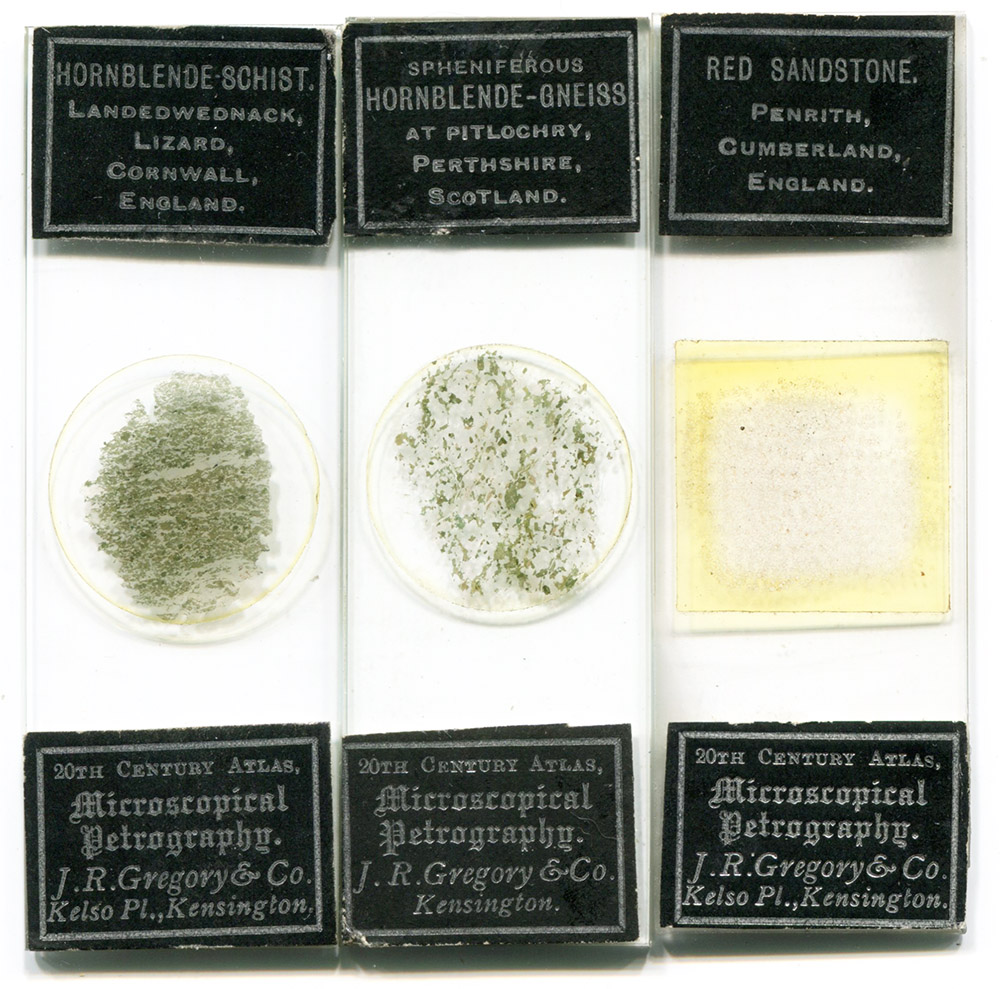
Figure 1. Microscope slides of thin-sectioned minerals by J.R. Gregory and Company, to accompany E.H. Adye’s 1906 “Twentieth Century Atlas of Petrology”.
James Reynolds Gregory, 1832 - 1899
Albert George Frederick Gregory, 1864 - 1936
by Brian Stevenson
last updated June, 2024
J.R. Gregory opened a mineral and fossil shop in London in 1858. This and other such hobby businesses flourished with the increased disposable income of the growing middle class and their interests in the sciences. Through the rest of century, Gregory moved to a succession of larger spaces, eventually referring to his shop as a “museum”. Son Albert took over the business after his father’s death, operating as James R. Gregory & Company. Gregory bought up several competitors during the 1920s, then was itself acquired by E.P. Bottley in 1931. His combined business was called Gregory, Bottley & Company.
Both Gregory & Co. and Gregory, Bottley & Co. produced and sold microscope slides of minerals, both thin-sections and thick, three-dimensional mounts (Figures 1, 2, and 4). Advertisements from James Gregory suggested that he also sold slides during the late 1800s, although I am not aware of any with his name on them.
James Gregory also had a connection to a prolific professional microscope maker whose name remains unknown, but is referred to by slide collectors as Greenpapers”“. Beginning in 1874, Gregory sold collections of minerals to accompany Archibald Geikie’s Science Primers: Geology. Among the groups of 22 or 40 specimens were “ooze from bottom of Atlantic” and “grains of chalk”, both “prepared for the microscope”. A number of slides by Greenpapers are known that hold those specimens and have numbers attached that correspond with Gregory’s lists (Figure 5). Specimens by Gregory also have the same squares of paper with printed numbers (Figure 6). While it is not likely that James Gregory was Greenpapers, the existence of these slides indicate that the two people knew each other to some extent.

Figure 1.
Microscope slides of thin-sectioned minerals by J.R. Gregory and Company, to accompany E.H. Adye’s 1906 “Twentieth Century Atlas of Petrology”.
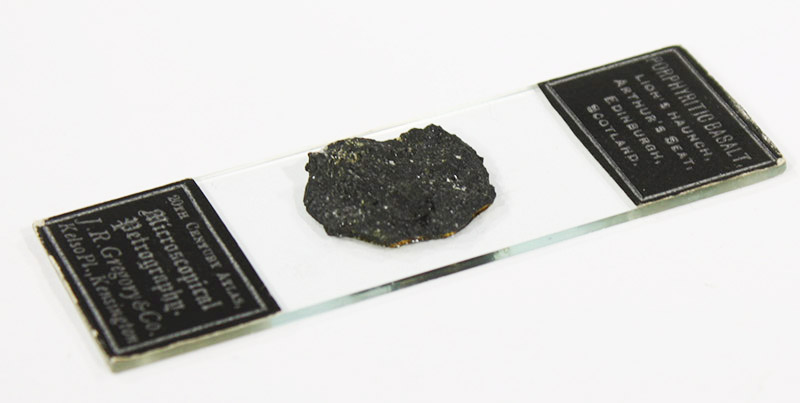
Figure 2.
A microscope slide with a three-dimensional piece of mineral, by Gregory and Company, also to accompany Adye’s “Twentieth Century Atlas of Petrology”.
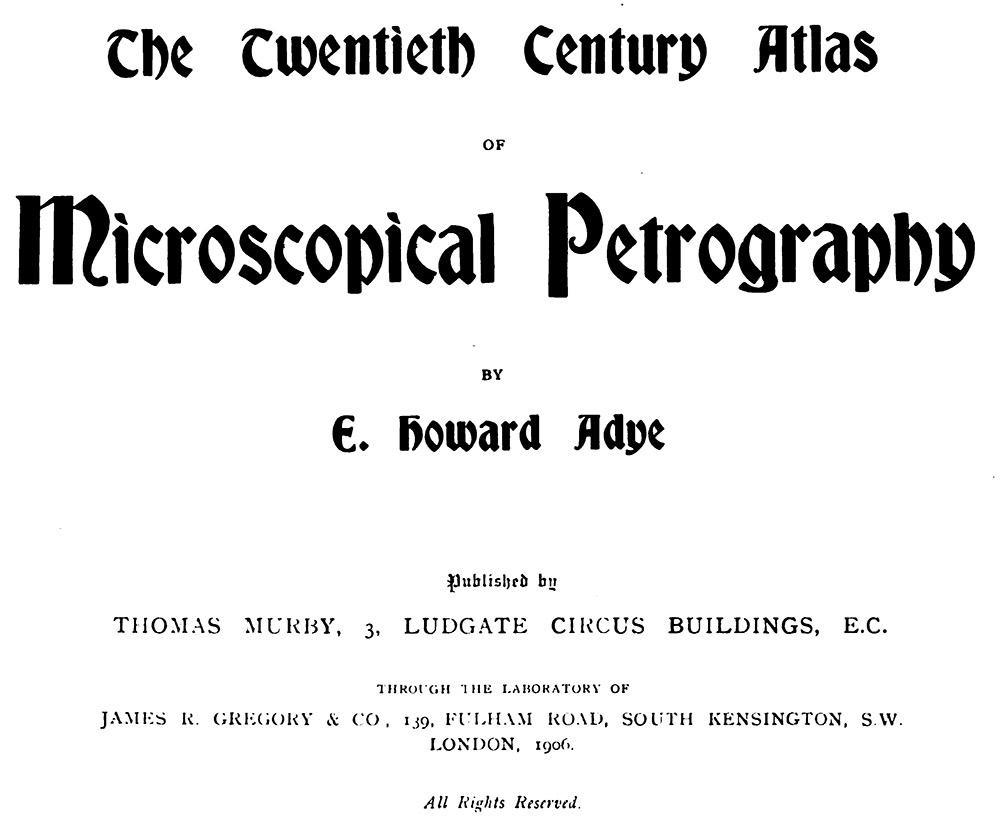
Figure 3.
Title page of E. Howard Adye’s “Twentieth Century Atlas of Petrology”, 1906. It was published “through the laboratory of James R. Gregory Co.”
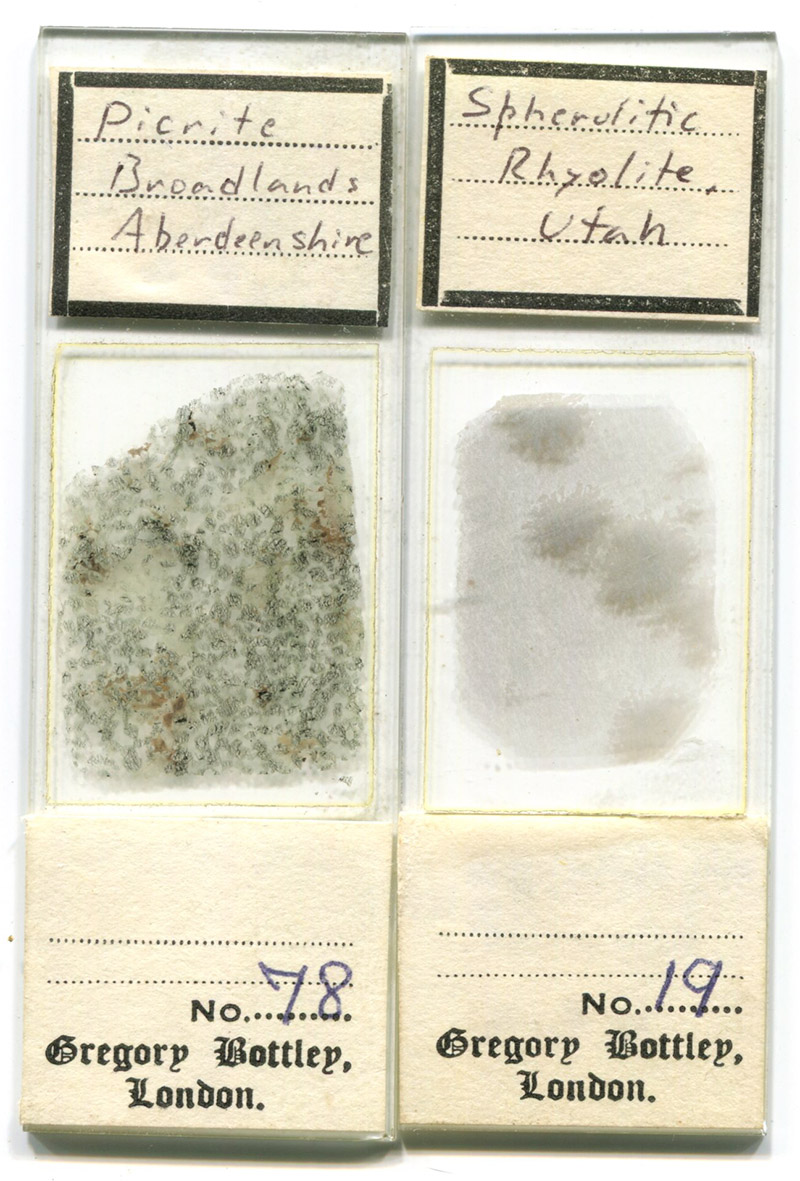
Figure 4.
Mineral thin-section microscope slides by Gregory, Bottley & Co., dating from after E.P. Bottley’s acquisition of Gregory in 1931.
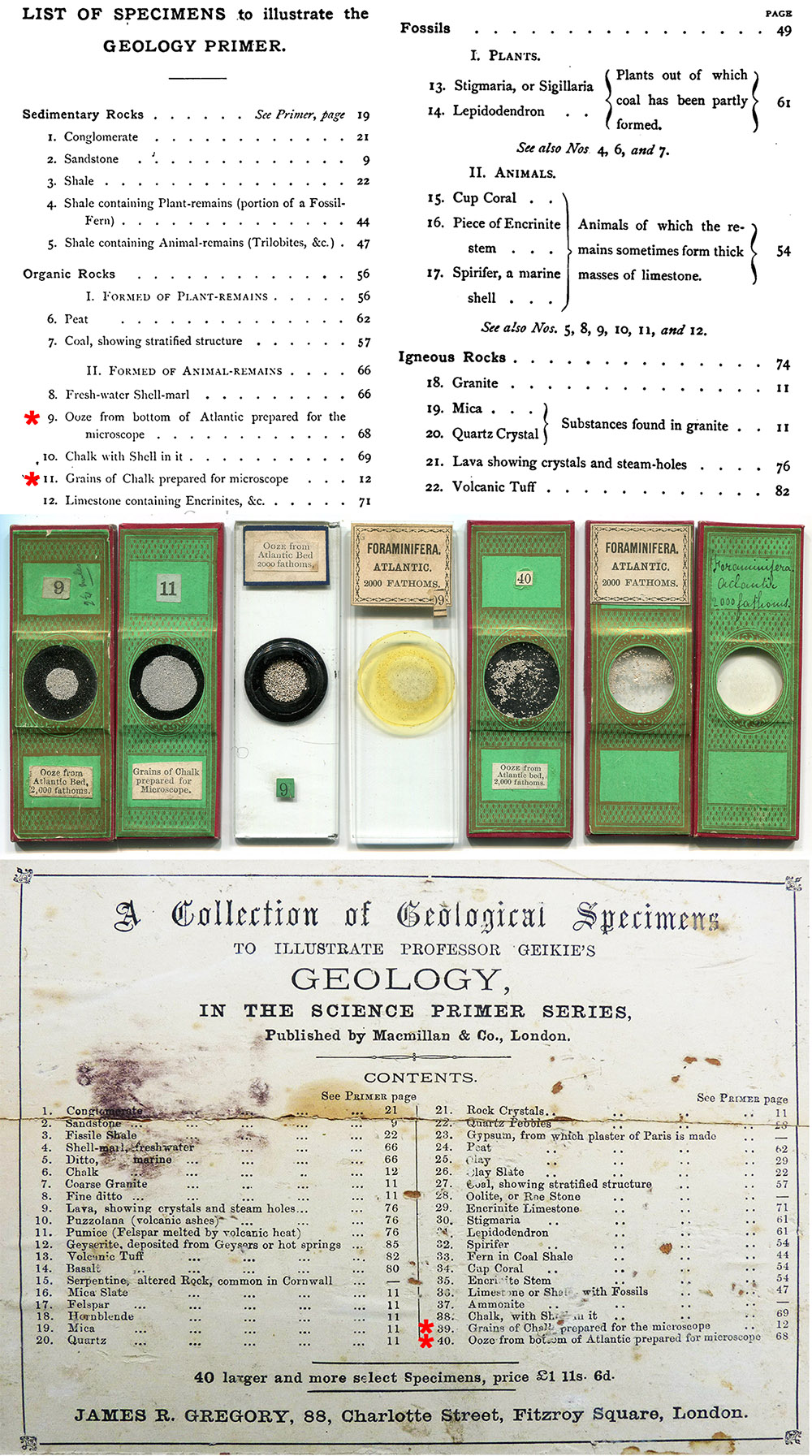
Figure 5.
Lists of specimens provided by J.R. Gregory to accompany Archibald Giekie’s “Science Primers: Geology”, and slides by the unknown professional microscopist Greenpapers”“ that match Gregory’s descriptions and numbers of specimens “prepared for the microscope”. Top, from the 1874 second edition of “Science Primers: Geology”. Bottom, a list on a box of mineral specimens (see Figure 6). Note that the 1874 list includes 22 specimens, with the slides being numbers 9 and 11, while the later list includes 40 specimens, with the slides as numbers 39 and 40. Gregory’s shop occupied 88 Charlotte Street, Fitzroy Square from late 1874 until 1895.
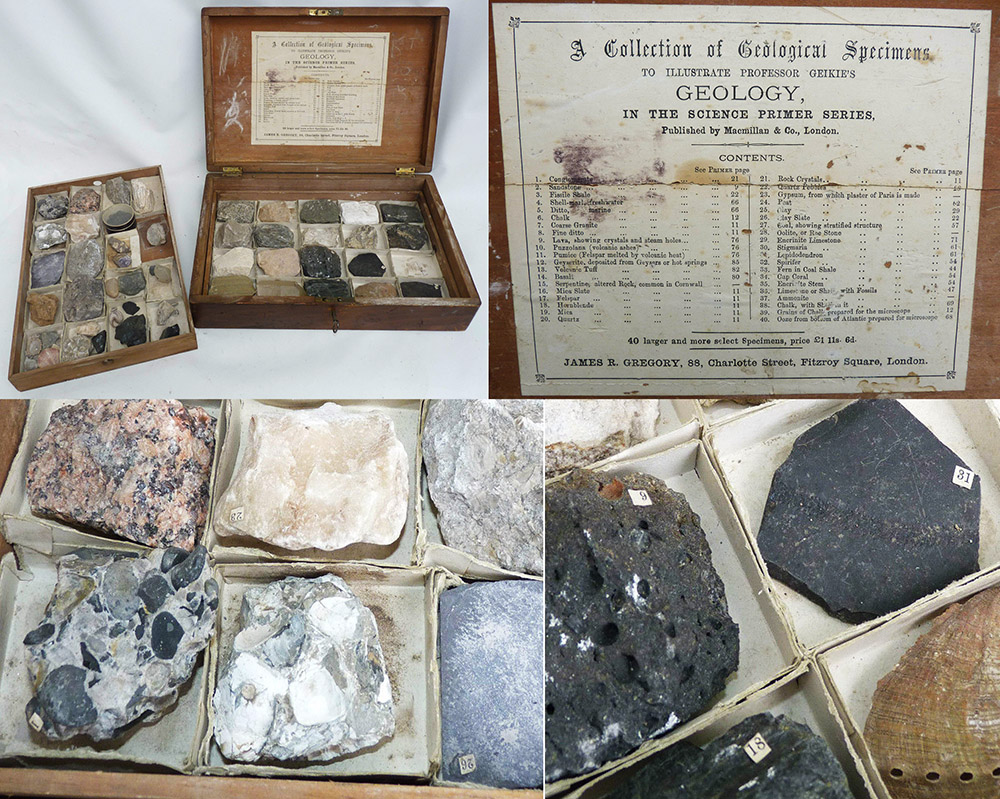
Figure 6.
A box of minerals from James Gregory, to accompany Archibald Giekie’s “Science Primers: Geology”. Note that the minerals bear small paper squares with printed numbers, of a style that match those on Greenpapers”“ microscope slides (see Figure 5). Gregory had begun including 40 specimens in his Geikie collections by 1887. Images adapted for nonprofit, educational purposes from an internet sale site.
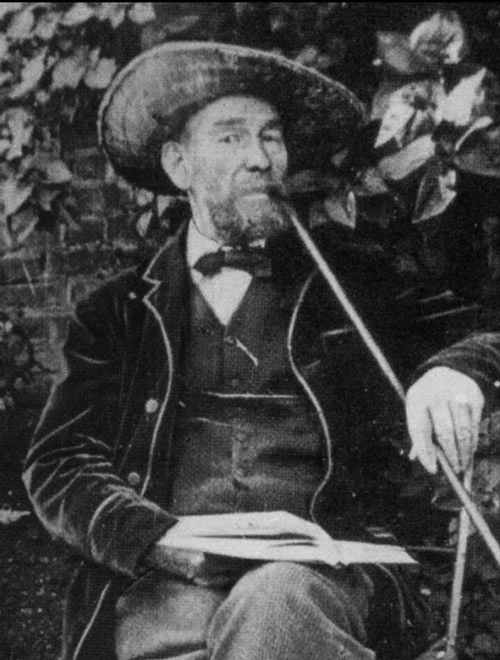
Figure 7.
Photograph of James R. Gregory, circa 1880.
J.R. Gregory occupied numerous locations in London. Addresses and dates:
1858 - 1859: 59 Frith Street
1859 - 1861: 3 King William Street
1861 - 1866: 25 Golden Square
1866 - 1874: 15 Russell Street, Covent Garden
1874 - 1895: 88 Charlotte Street, Fitzroy Square
1895 - 1905: 1 Kelso Place, Kensington
1905 - 1926: 139 Fulham Road, South Kensington
1926 - 1931: 30 Church Street, Chelsea
James Reynolds Gregory was born in London on December 29, 1832. He was the third child, and second son of John and Sarah Gregory. James’ baptism record gives his father’s occupation as “baker”, but he was working as a “clerk” by the time of the 1851 census. Mother Sarah worked as a “milliner” (hat maker). The family evidently valued education and was willing to spend money for it, since James was reported to have attended Archbishop Tennison's School, in Leicester Square.
According to the 1851 census, the 18 year-old James and his elder brother both worked as “barrister’s clerks”. This career apparently did not appeal to James. The earliest known record of his mineral and fossil business is an advertisement that appeared in the May 15 issue of The Athenaeum (Figure 8). It describes a relatively extensive variety of items for sale, suggesting that he may have acquired the stock of another dealer.
James married Elizabeth Ann Williams on April 20, 1859. They had two children, the youngest of whom, Albert, succeeded to his father’s business.
Gregory moved his shop and home to 3 King William Street, Strand, in 1859 (Figure 9). He moved again in early 1861, to “very extensive premises” at 25 Golden Square (Figure 10). Yet another move took place in 1866, to “more commodious and convenient premises” at 15 Russell Street, Covent Garden (Figure 12).
Gregory exhibited a collection of minerals at the 1862 International Exposition in London, and won the only award given for that topic. He also won an award at the 1867 Paris Exposition for his exhibit of minerals, fossils, and precious stones.
Also in 1867, he issued Elementary Geology: Illustrated by twenty-seven actual specimens of the common rocks and fossils of Great Britain, with the name, geological position and locality of each, for the use of beginners, schools, etc. As the name implies, included “Specimens mounted inside wooden and cardboard boxes made in the shape of a book with blue cloth spine and marbled boards”.
James’ wife, Elizabeth, died during the 1860s, probably toward the end of the decade. He remarried on February 15, 1871, to Cassandra Elizabeth Law. They had 5 children.
As noted above, Gregory began selling collections of minerals to accompany Archibald Giekie’s Science Primers: Geology. He advertised a collection of 22 minerals and microscope slides in the 1874, second edition of the book (Figure 5). By 1887, Gregory had expanded his Giekie collection to 40 specimens (Figure 5).
In December, 1874, Gregory moved his shop to “newly-built premises” at 88 Charlotte Street, Fitzroy Square (Figures 14 and 15).
James Gregory began making moves to retire in the mid-1890s. His eldest son, Albert, took over the business and the name was changed to “James R. Gregory Company.” The shop also made another move, to 1 Kelso Place, Kensington. An 1896 advertisement specifically stated that the Gregorys sold “microscopic sections of rocks and minerals” (Figure 17).
James Gregory died on December 15, 1899, at his home at 29 Shaftesbury Road, Ravenscourt Park. His obituary in Mineralogical Magazine read:
“The late J. R. Gregory was born in London, Dec. 29th, 1832, and in early boyhood evinced great interest in minerals and fossils; he was educated at Archbishop Tennison's School in Leicester Square, W.C., and having started in life as an expert in gems, became well known as a geologist and mineralogist. He exhibited in the Paris Exhibition of 1867, where he gained a medal for the excellence of his minerals, &c., and also in the Fisheries and Health Exhibitions. For the Indian and Colonial Exhibition in 1887 he wrote the report of the minerals and gems at the request of H.R.H. the Prince of Wales. He possessed a very wide and extensive knowledge of minerals, gems and meteorites,. and was frequently consulted on these subjects by many who appreciated his excellent judgment. His collection of meteorites was formed during a period extending over 40 years, and was an extremely fine one. In 1867 he went to the Cape to prospect for diamonds, and one result of this expedition was the wide introduction into Europe of the now well known crocidolite from Griqualand.
Mr. Gregory died on Dec. 15th, 1899. He was a member of the Geological Society, of the Mineralogical Society of Great Britain, of the Mineralogical Society of France, of the Geologists' Association, and, until within four years of his death, of the Society of Arts.”
Albert married earlier in 1899, to Annie Mahala Joslin. They did not live at the shop, but instead had a house at 113 Dalling Road, Hammersmith.
Albert moved the business a final time in 1906, to 139 Fulham Road, South Kensington (Figure 20). Business may have been slipping, as the Gregory family lived at the shop. By the time of the 1911 census, they had taken in boarders.
Around 1926, the Gregory business moved to 30 Church Street, Chelsea.
In 1927, Gregory took over the business of Francis H. Butler (1849-1935) (Figure 21). Around the same time, they acquired Russell and Shaw (the successors of Thomas D. Russell [1839-1928]).
Gregory & Company were in turn acquired by E. Percy Bottley, formerly of Derby. The business continued at 30 Church Street as Gregory, Bottley Company (Figure 22). After Bottley’s death, it was acquired by Brian and Mary Lloyd and continued until 2014 as Gregory, Bottley & Lloyd.

Figure 8.
1858 advertisements by James Gregory, from 59 Frith Street, Soho, London. The advertisement on the left was published on May 15, 1858, and is the earliest known mention of Gregory’s fossil and mineral business. From “The Anthenaeum”.
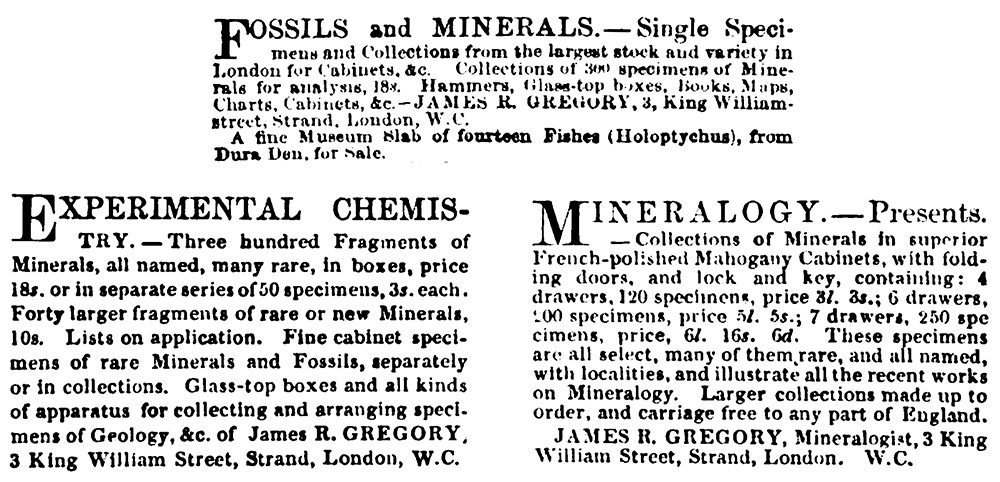
Figure 9.
1859 and 1860 advertisements, from 3 King William Street, Strand. Gregory moved his shop and home to that location in 1859. From “The Anthenaeum” and “Chemical News”.
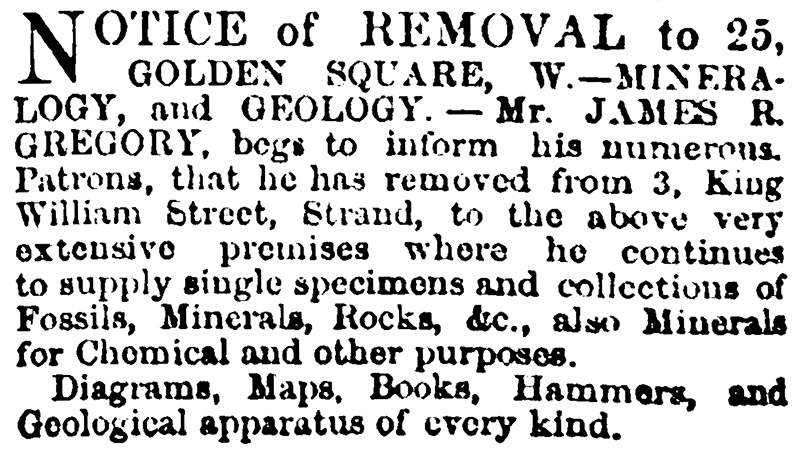
Figure 10.
February 23, 1861 advertisement, announcing Gregory’s move to 25 Golden Square. From “Chemical News”.

Figure 11.
1864 advertisements, from “The Geological Magazine”.

Figure 12.
1866 notice of Gregory’s move to 15 Russell Street, Covent Garden. From “The Anthenaeum”.
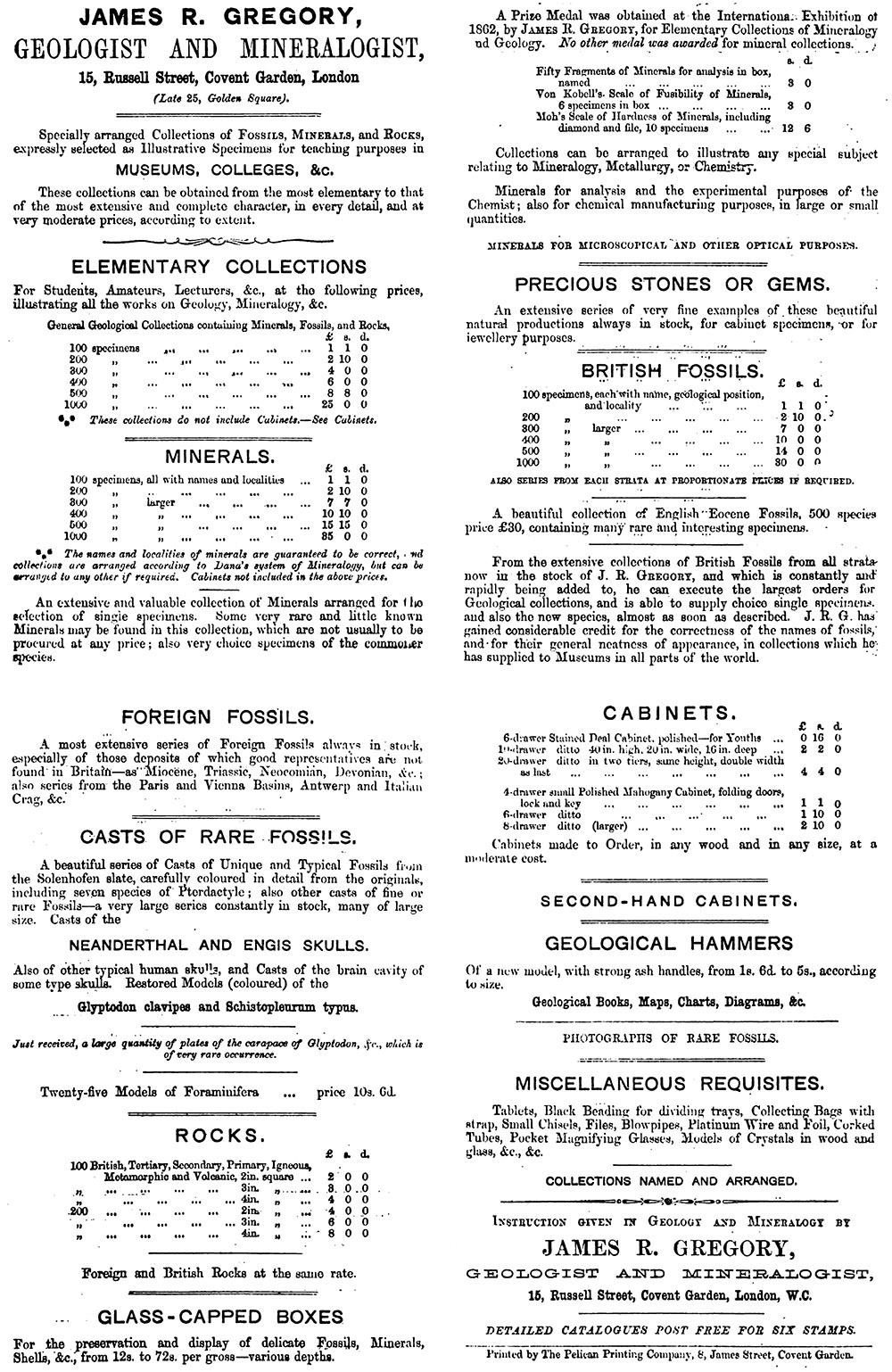
Figure 13.
1867 advertisement from “Catalogue of the Educational Division of the South Kensington Museum”.
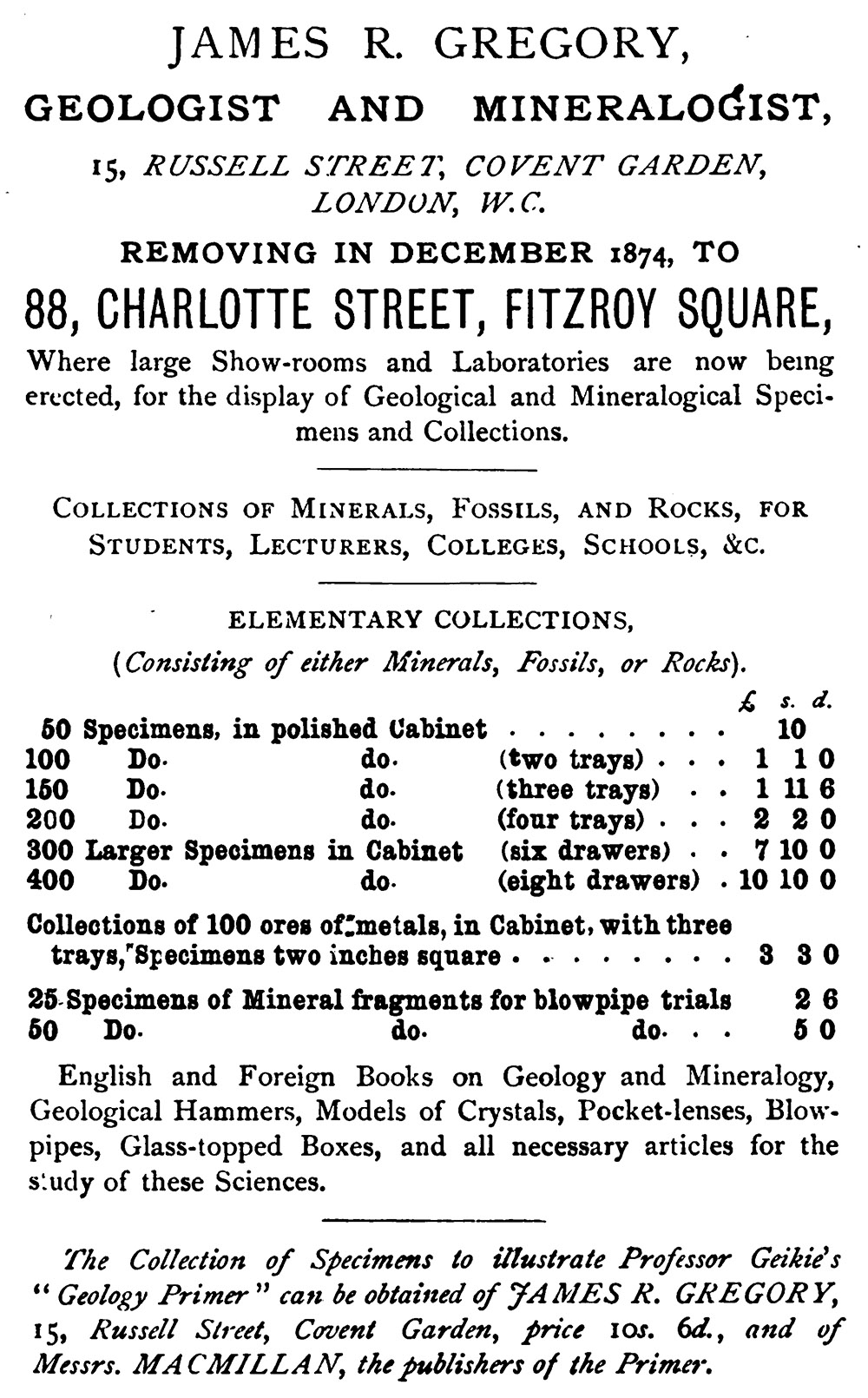
Figure 14.
1874 advertisement, from Archibald Giekie’s “Science Primers: Geology”.

Figure 15.
1874 advertisement, noting Gregory’s move to 88 Charlotte Street, Fitzroy Square. From “Nature”.
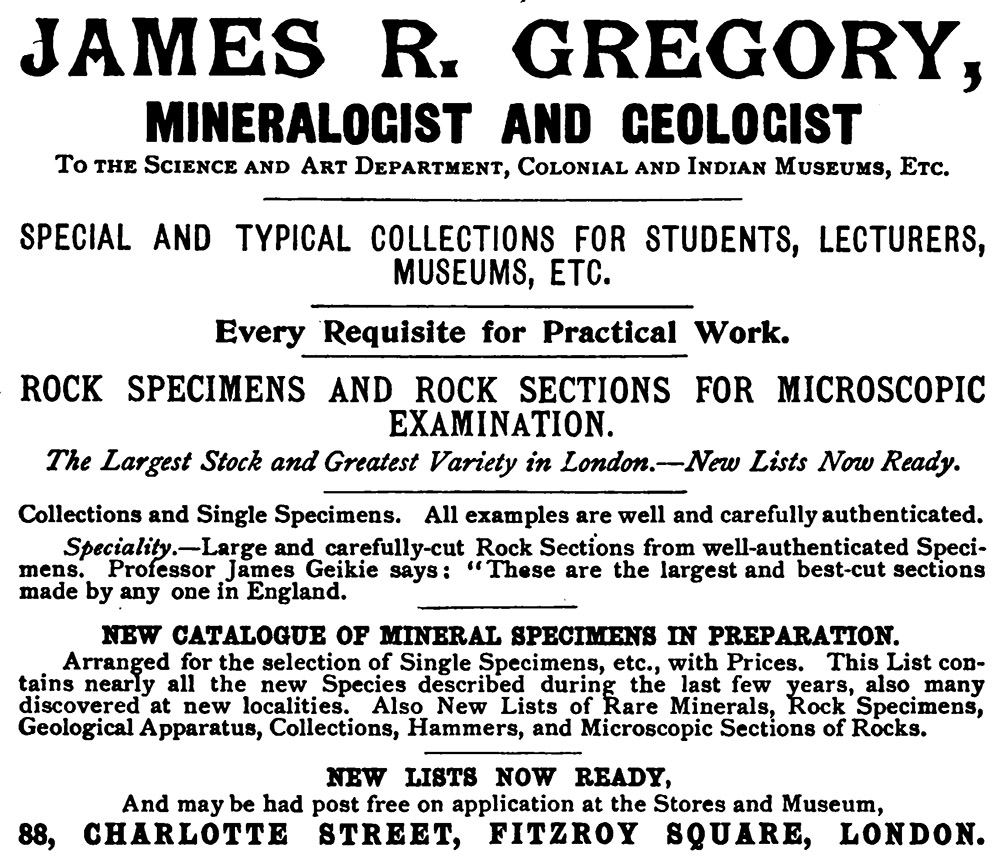
Figure 16.
An 1894 advertisement. Gregory’s mention of “rock sections” may indicate that he then sold microscope slides. From “Museums Association Report of Proceedings”.
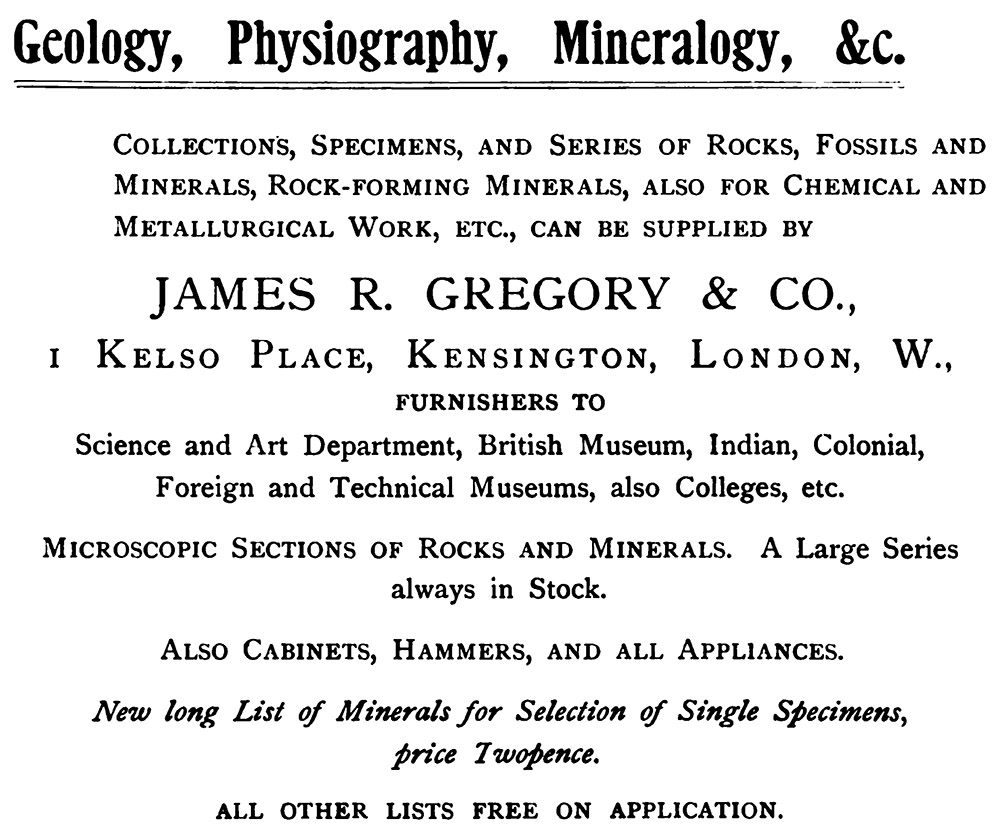
Figure 17.
An 1896 advertisement. James’ son, Albert, became a business partner, and the name changed to “James R. Gregory & Company”. The shop also moved at that time, to 1 Kelso Place, Kensington. Note that they now specifically stated that sold “microscopic sections of rocks and minerals”. From “Museums Association Report of Proceedings”.
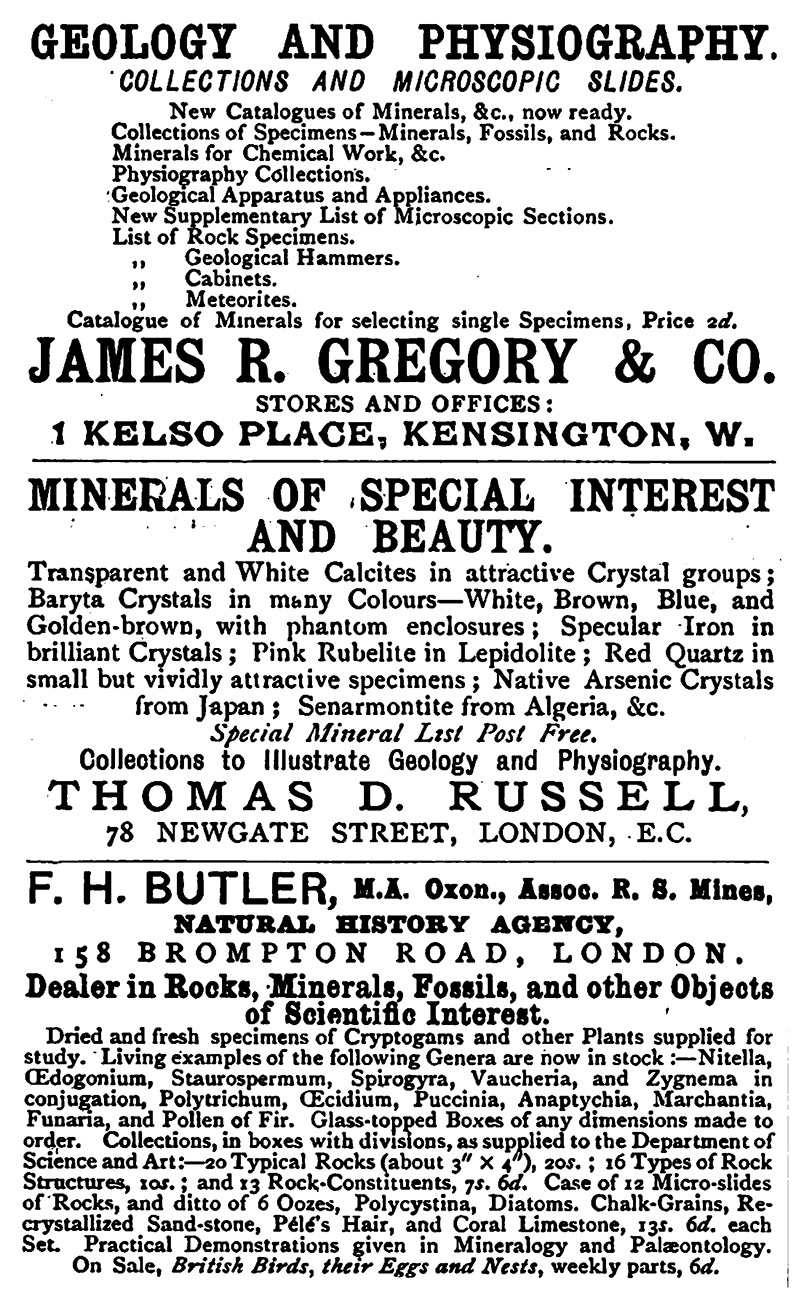
Figure 18.
1897 advertisements that appeared adjacent to each other in “Nature”. By 1930, Gregory Co. had acquired the businesses of both T.D. Russell (as Russell & Shaw) and F.H. Butler. Note that Gregory advertised “microscopic slides”.
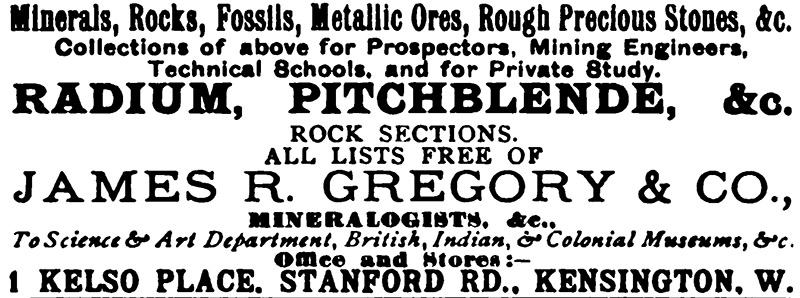
Figure 19.
1904 advertisement, from “Nature”.
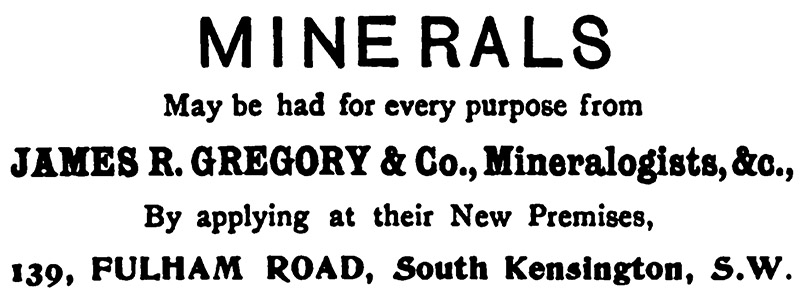
Figure 20.
1906 advertisement, announcing yet another move, to 139 Fulham Road, South Kensington. From “Chemical News”.

Figure 21.
1927 announcement that Gregory had taken over the stock of F.H. Butler. From “Rocks and Minerals”.
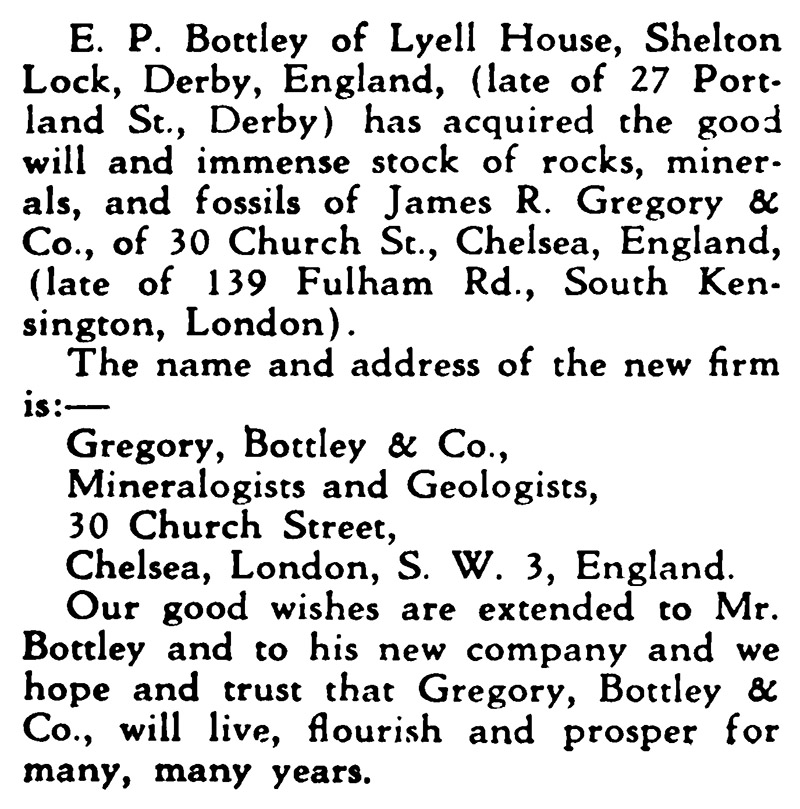
Figure 22.
1931 announcement that James R. Gregory & Company had been acquired by E. Percy Bottley, to be continued as Gregory, Bottley, and Company. From “Rocks and Minerals".
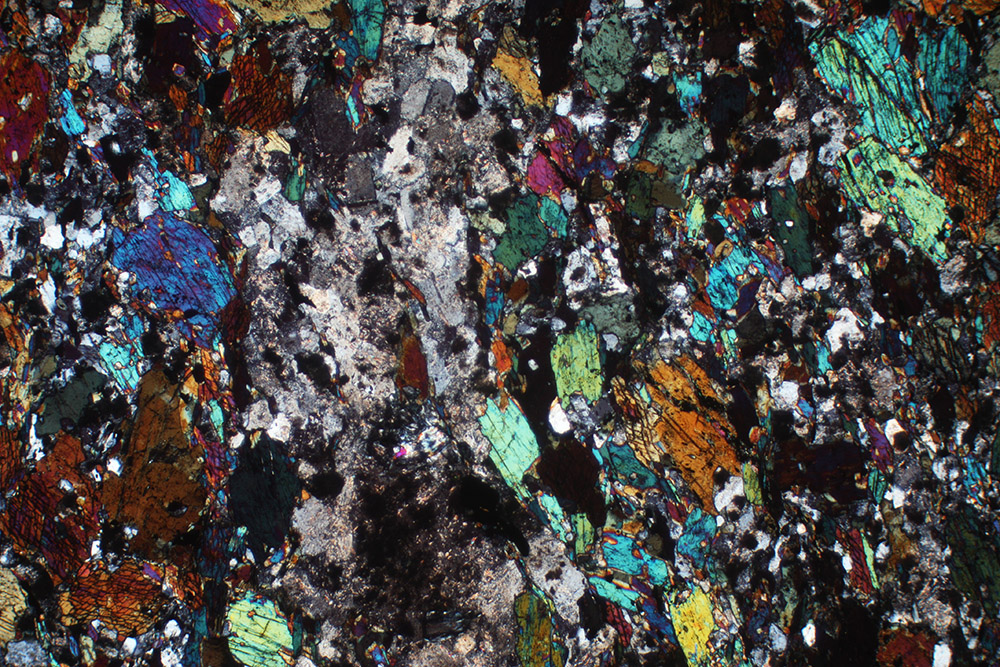
Figure 23.
Hornblende-Schist from Landedwednack (sic), Lizard, Cornwall, prepared ca. 1906 by J.R. Gregory & Co., to accompany E.H. Adye’s “Twentieth Century Atlas of Petrology”. Imaged with a 3.5x objective lens, crossed polarizing filters, and a C-mounted digital SLR camera on a Leitz Ortholux II microscope.
Resources
The Athenaeum (1858) Advertisements from J.R. Gregory, May 15 and December 18
The Athenaeum (1859) Advertisement from J.R. Gregory, July 2
The Athenaeum (1861) Advertisement from J.R. Gregory, June 22 and November 23
The Athenaeum (1866) Advertisement from J.R. Gregory, June 16
Baptism record of James R. Gregory (1833) Parish of St. James, Westminster, accessed through ancestry.com
Bracegirdle, Brian (1998) Microscopical Mounts and Mounters, Quekett Microscopical Club, London, pages 47, 142, 206, and 208, and Plates 19-N, 51-E, and 52-E
Catalogue of the Educational Division of the South Kensington Museum (1867) page 346
The Chemical News (1860) Advertisements from J.R. Gregory, multiple issues
The Chemical News (1861) Advertisements from J.R. Gregory, February 23 and March 16
The Chemical News (1906) Advertisement from J.R. Gregory & Co., September 28
Embry, Peter G., and R.F. Symes (1987) Minerals of Cornwall and Devon, British Museum, London, page 74
England census and other records, accessed through ancestry.com
The Geological Magazine (1864) Advertisements from James R. Gregory, multiple issues
The Geologist (1859) Advertisements from J.R. Gregory, pages 136, 180, and 220
Geikie, Archibald (1874) Science Primers: Geology, second edition, edited by Thomas Huxley, Henry Roscoe, and Balfour Stewart, published by Macmillan and Co., London
Geikie, Archibald (1880) Science Primers: Geology, edited by Thomas Huxley, Henry Roscoe, and Balfour Stewart, published by D. Appleton and Co., New York (US edition)
Gregory, James R. (1887) Two new French meteorites, Geological Magazine, pages 552-554
Journal of the Legislative Council of New South Wales (1887) List of collection, showing that Gregory had sold them “forty specimens to illustrate 'Giekie’s Geology Primer'”, page 26
Le Pelley, Nicolette (2014, accessed June, 2024) End of an era for Gregory, Bottley & Lloyd, https://www.thehousedirectory.com/end-of-an-era-for-gregory-bottley-lloyd/
Marriage record of James R. Gregory and Elizabeth Ann Williams (1859) Parish records of St. Martin in the Fields, accessed through ancestry.com
Marriage record of James R. Gregory and Cassandra Elizabeth Law (1871) Parish records of St. Stephen, Islington, accessed through ancestry.com
Mineralogical Magazine (1900) Obituary of James R. Gregory, page 301
Museums Association Report of Proceedings (1894) Advertisement from James R. Gregory
Museums Association Report of Proceedings (1896) Advertisement from James R. Gregory
Nature (1874) Advertisement from J.R. Gregory, December 31
Nature (1894) Advertisement from J.R. Gregory, July 12
Nature (1895) Advertisement from J.R. Gregory, April 25
Nature (1897) Advertisement from J.R. Gregory, June 24
Nature (1899) Advertisement from J.R. Gregory, May 4
Nature (1904) Advertisement from James R. Gregory & Co., April 28
Paris Universal Exhibition of 1867. Catalogue of the British Section (1867) pages 142 and 150
Probate of the will of James R. Gregory (1899) “Gregory James Reynolds of 29 Shaftesbury-road Ravenscourt Park, Middlesex died 15 December 1899 Probate London 13 January to Cassandra Elizabeth Gregory widow Victor Herbert Gregory electrician and Leolin Charles Gregory architect’s-assistant Effects £4699 12s 7d”, accessed through ancestry.com
Probate of the will of Albert G.F. Gregory (1936) “Gregory Albert George Frederick of Melrose Woodchurch Ashford Kent died 5 May 1936 Probate London 10 June to Annie Mahala Gregory Widow. Effects £1901 7s 6d”, accessed through ancestry.com
Proceedings of the Geologists' Association (1859) “Ordinary Meeting, 8th March, 1859 …The following ladies and gentlemen were elected Members of the Association:… Mr. J.R. Gregory”, page 6
Rocks and Minerals (1927) Announcement that Gregory Co. had acquired the stock of F.H. Butler, page 77
Rocks and Minerals (1931) Announcement that E.P. Bottley had James R. Gregory & Co., page 125